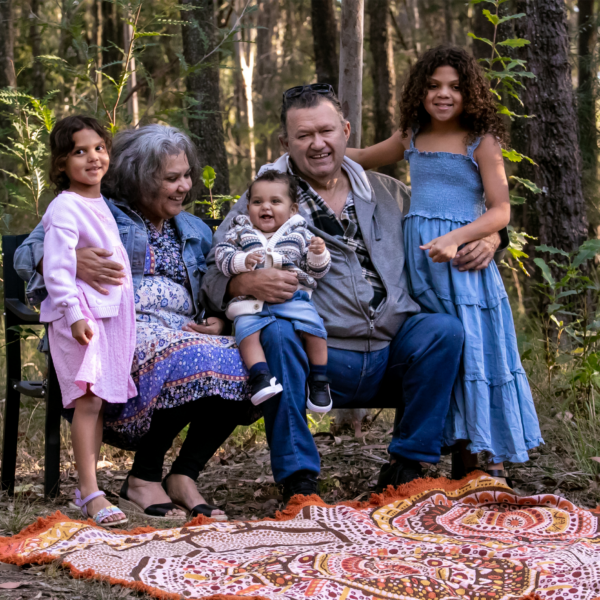Blog
Breaking the Australian Monolingual Mindset: IG programmes and language revitalisation

More than 90% of Australia’s Indigenous Aboriginal languages are at risk of disappearing. Intergenerational programmes involving elders can help reverse this trend. Read Sophia Stirling’s blog about this issue.
According to the Australian Bureau of Statistics as of June 2022, 27.6 per cent of the population were born overseas. Twenty-seven per cent spoke a language other than English at home. Despite the culturally and linguistically diverse population, English dominates, often overshadowing the rich repertoire of Australia’s cultural and historical heritage.
Our national Early Year Learning Framework acknowledges the linguistic diversity of Australia. Teachers must “plan experiences and provide resources that broaden children’s perspectives and encourage appreciation of diversity, including disability, family diversity, cultural and language diversity” (Australian Government Department of Education, 2022). Despite this, most curricula in early childhood (and in primary and secondary schools) are in English.
 In Australia we do not have to look far to see successful programmes that promote cross-generational language and cultural learning in educational settings. In Aotearoa New Zealand, our neighbouring country ‘Kōhanga Reo’, or ‘Language Nest’ programmes have been implemented since the 1980s. These are supported by government and have been key in revitalising and maintaining Māori language. The Language Nest approach involves immersing young children (from birth to 6 years of age) in the language and culture through interactions with elders who are fluent speakers ensuring Māori survival and children’s continued engagement (Rameka & Peterson, 2021).
In Australia we do not have to look far to see successful programmes that promote cross-generational language and cultural learning in educational settings. In Aotearoa New Zealand, our neighbouring country ‘Kōhanga Reo’, or ‘Language Nest’ programmes have been implemented since the 1980s. These are supported by government and have been key in revitalising and maintaining Māori language. The Language Nest approach involves immersing young children (from birth to 6 years of age) in the language and culture through interactions with elders who are fluent speakers ensuring Māori survival and children’s continued engagement (Rameka & Peterson, 2021).
The situation regarding Indigenous languages is much less favourable in Australia where more than 90% of Aboriginal languages are critically endangered. Two-thirds of those languages spoken a hundred years ago are now dormant. Australia’s dark history towards Aboriginal peoples, of genocide, forced population removal, stolen children, and community disruption have all impacted the vitality of Indigenous languages. To date, Australian educational policies have neglected to promote the use of Indigenous languages within the school system, despite research continuously showing the benefits this has on children’s access and outcomes in education.

Australia’s recent and troubled history in its treatment of Aboriginal people raises significant power dynamics, including who has the authority to teach and learn language. For some Aboriginal communities, control over their language may represent one of the few areas where they still hold autonomy. The Master-Apprentice Language Learning Program is another programme following an intergenerational learning approach that has helped the revitalisation of Indigenous languages around the world. It was originally developed in California by and for Native American communities. This programme pairs a language learner (the apprentice) with a fluent speaker (the master, often an elder) in a one-on-one setting, fostering direct and personalised language transmission. This model is particularly significant for ensuring direct transmission in an authentic way, which is essential for nuanced understanding of languages. It could also be adapted to Australian ECEC and primary school contexts as a strategy for language revitalisation (Hinton et al., 2018).
By embracing the Language Nest Model or the Master-Apprentice programme model in Australia, we could tap into the rich cultural tapestry of the Australian demographics, and hopefully challenge the monolingual mindset that has long dominated our educational landscape. This could pave the way for more linguistically diverse, culturally rich, and interconnected Australian society, where languages and cultures are shared across generations.
Author: Sophia Stirling, Department of Early Childhood Education, Victoria University
Contact: Sophia.Stirling@vu.edu.au
Read also this blog by Libby-Lee Hammond and Elizabeth Jackson-Barrett about IGL in Australian Aboriginal communities http://www.toyproject.net/2016/06/intergenerational-learning-on-country-in-western-australia/
References:
Hinton, L., Florey, M., Gessner, S., Manatowa-Bailey, J. (2018). The Master-Apprentice Language Learning Program. In L. Hinton, L. Huss., & G. Roche (Eds.), The Routledge Handbook of Language Revitalization. (pp. 127-136). Routledge. https://doi.org/10.4324/9781315561271
Rameka, L., & Peterson, S. (2021). Sustaining Indigenous languages and cultures: Māori medium education in Aotearoa New Zealand and Aboriginal Head Start in Canada. Kotuitui New Zealand Journal of Social Sciences Online, 16(2), 307-323.